If you want to be part of one major operatic excitement of the past dozen years, you have to see Les Troyens, The Trojans, by Hector Berlioz. The French composer who wrote the opera in 1856-58, never saw it performed. Neither did many opera lovers. Les Troyens was considered too big, too epic, too unwieldy for the stage. The work is based on the Aeneid, Virgil’s epic poem about the fall of Troy,
connecting the mythical city and its warrior hero Aeneas to two powerful women--the visionary priestess Cassandra in Troy and the great passionate lover, Dido, in Carthage. Aeneas, with some of his men and his son Ascanius, escapes the burning Troy with the mission to go to Italy and lay the foundation for the future Roman Empire. It didn’t help Les Troyens that Berlioz was mostly known for his
symphonic work, not for his few attempts at opera. And here he proposes music of epic length and dimension, a gigantic orchestra, three different groups of horns back-stage, a huge chorus that has to be onstage 75 % of the time, the setting of two cities, Troy and Carthage, several ballets and, of course, the monster of a horse! 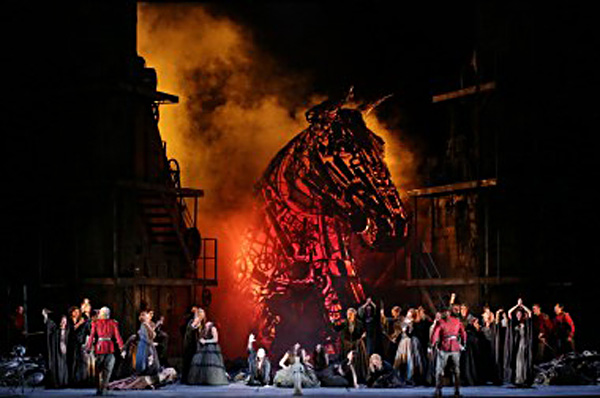 |
2003, the 200 year anniversary of the composer’s birth, brought the giant out of the shadows. With a vengeance, one could say, as from that moment, Les Troyens has become all the rage. Every major opera
house of the world has to be in on it, and for good reason. Berlioz’s operatic writing is as revolutionary as Wagner’s (but uninfluenced by his great contemporary). The libretto is his own; he pulls recitatives and arias into rich dialogues with the orchestra, expands into purely orchestral passages, and changes storytelling rhythms with a superb (some say Shakespearean) sense for drama. The result is five hours of exciting, shattering and heart-wrenchingly lyrical music: an
extraordinary discovery that occupies a pinnacle right next to the 5-hour masterpieces of Wagner’s Ring. Instant Classic To get into Les Troyens, you have two excellent DVD options. There is a 2003 production from Paris (the first-ever French presentation
without cuts), and a 2013 London production. (Be careful to avoid the dusty, hammy Met telecast from 1983 with Jessye Norman, Tatiana Troyanos and Placido Domingo). The Paris version, from the Théâtre du Chatelet, is a brilliant affair. Directed by Greek stage director and set designer Yannis Kokkos and conducted by Sir John Eliot Gardiner, it already presents two of
today’s major players in the cast: Italian soprano Maria Caterina Antonacci as Cassandra and American mezzo Susan Graham as Dido. American tenor Gregory Kunde is Aeneas. This version became an instant classic, the gold standard that every new production will have to measure itself against. The Met, in a 2012 revival of its 2003 anniversary production by Francesca Zambello, with Deborah Voigt, Susan Graham and Marcello Giordani, could not compete.
But the 2013 production at the Royal Opera in London, directed by another seasoned theater maker, David McVicar, and conducted by Antonio Pappano, is a worthwhile, if more traditional rival -- with once again Antonacci as Cassandra, Dutch diva Eva-Maria Westbroek as Dido and young American tenor Brian Hymel (who stepped in for an ailing Jonas Kaufmann) as Aeneas. If you were lucky to be in San Francisco this summer, you could enjoy the same London production
, conducted this time by Donald Runnicles, with Antonacci and Hymel and again Susan Graham as the queen of Carthage who falls in love with Aeneas and kills herself when he sails off for Italy. Antonacci as Cassandra So, luck has it that Antonacci is in all three versions, Graham in Paris
and live in San Francisco, Westerbroek and Hymel in London, and also Hymel live in San Francisco. 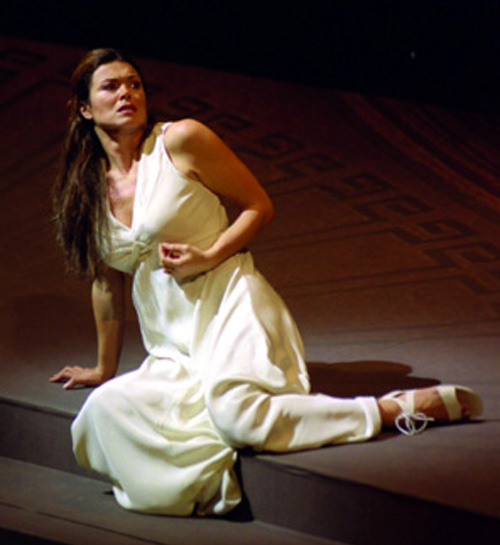 |
It was a thrill to see Antonacci in two very different portraits of Cassandra. On the Paris DVD she is a beautiful woman in a glowing, snow-white dress, intense in her dismay and mourning over the naïve Trojans who don’t see what she sees – the end of Troy, the murderous violence of the Greek army set to explode from the belly of the horse. Before she arrives onstage, brooding among the jubilant
Trojans who celebrate the vanishing of the Greek army, no string instrument is to be heard in the orchestration. The strings only rise with Cassandra’s despair. Antonacci’s dark and at the same time luminous voice, impeccable French, and her expressive body language paint Cassandra as a modern woman of mythical proportion– a woman alone with her intuition, who struggles to hold back the violence of her prophetic visions. Like a white bird beating
her wings against a cage, she cannot move the men in power, cannot convince her lover Corebus nor her father, King Priam, who lets the horse enter the city, welcoming it as a sacred gift. 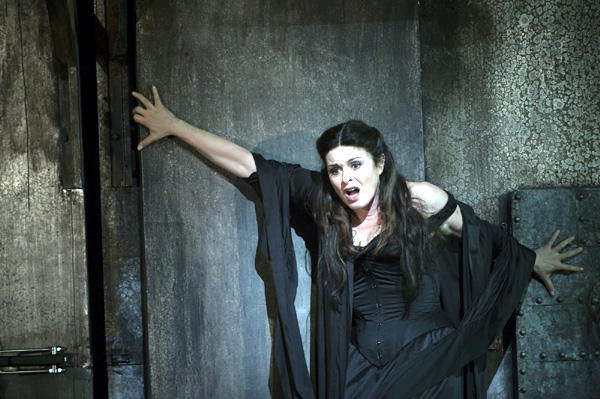 |
In London and San Francisco, under McVicar, Antonacci is even more intense. In flowing black, the palms of her hands painted with the staring eyes of a seer, she seems possessed, writhing through imaginary ceremonies of death. She knows that before the night is over she and almost everyone will be killed. 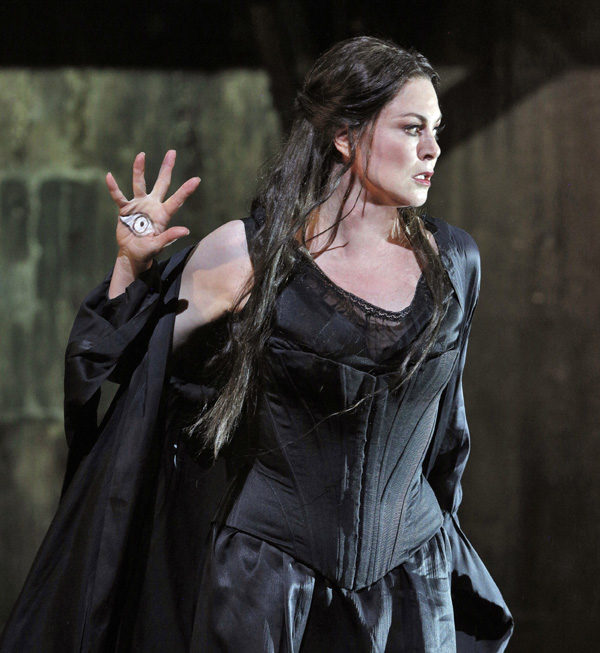 |
No matter how well one remembers the story of Troy, Berlioz creates extraordinary suspense, emotion and dread in his storytelling. The
death of the priest Laocoön-–punishment for attacking the treacherous horse--is told by Aeneas, and an outcry of pity and horror rises from the crowd. The long choral passage is like a mass of mourning and at moments a blood-curdling dirge. It is seemingly focused on the way Laocoön and his sons are swallowed alive by monstrous serpents rising from the sea, but is composed in anticipation of Freud and the unconscious as if the people of Troy
already knew what only the audience knows (and Cassandra intuits): that there is no hope any more, no recourse against destiny. 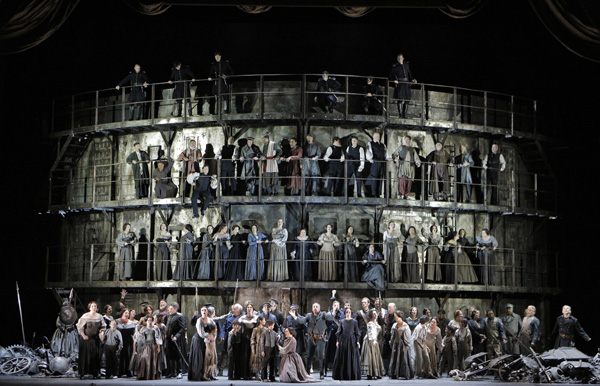 |
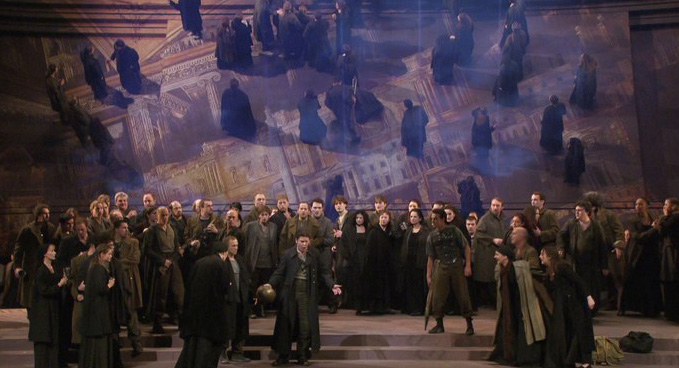 |
Troy, in McVicars version (sets be Es Devlin), is a formidable fortress
made of iron weaponry that breaks open to let in the Trojan horse. In the Paris version by Yannis Kokkos (sets and costumes also by the director), the city appears to be sunken, already gone like a poetic memory. The mythical aspect of the tale and its timeless relevance are caught as dreamlike images in a mirror. The entire stage-back is a slanted mirror reflecting, breaking up and doubling movements like a post-modern commentary: everyone who comes forward is at the
same time always moving backwards as if receding into the past. Andromaque, the widow of Hector (Troy’s most valiant warrior slain by Achilles), appears with her orphaned son in a long, mute procession of grief expressed solely in the laments of a clarinet. In McVicar’s version, she is dressed in her faded wedding gown. Cassandra approaches as if to take a dangerous spell off mother and
son, but can’t help telling Andromaque the truth: “Save your tears for the greater horrors to come.” “Extreme Warhorse” In the London and San Francisco production the metallic-looking horse is impressive as it should be. But similar to the giant dragon in Wagner’s Siegfried, one judges and applauds the prop with a certain
amusement. (The NY Times expertly called it “extreme War Horse.”)
The Paris setting stays in the metaphoric realm with the projection of a white horse head that looks blind and downright scary, but fails to reach the overpowering dimension onstage one expects and oddly wishes for. Before the horse is even visible, the greeting fanfare of the “Trojan March,” played by three stacked groups of horns back-stage, sounds like a haunting, hollow declaration of a triumph that is in fact a defeat--a motive Berlioz develops throughout the opera. In Act II, when Troy is burning, Cassandra urges the Trojan women to kill themselves together with her rather than submit to rape, torture and enslavement. As the Greek soldiers rush in they are stopped in their tracks by the sight of the women driven by Cassandra to an ecstatic frenzy “like bacchantes.” But only McVicar and conductor Pappano bring across the mortal ecstasy that Berlioz wrote
into the text and score. In this powerful scene the kneeling women practice their collective suicide to an accented, stab-like percussion beat in the music (ignored in Sir Eliot Gardiner’s conducting). They keep repeating the stab of the dagger and the pain reaction of the body like a frantic dance move until they fall with the cry, “Italy” Italy!” Happy Carthage In Carthage, Act III, IV and V, things get complicated through apparent happiness. The Paris mise en scène makes do with a few
elegant Mediterranean symbols and golden light for the African desert city. In London/San Francisco the stage is a replica of the massive Trojan city wall: now a mid-Eastern terracotta wall, beautifully ornamented and curved inward like an embrace. Another prop, a model of the city itself, symbolizes the industriousness of builders and artisans who enthusiastically celebrate their patroness, Queen Dido.
Susan Graham (Paris and San Francisco) and Eva-Maria Westbroek (London) are equally radiant Didos with flowing robes and abundant locks. Westbroek is more maternal, hugging and kissing her people like children. Graham is more reserved, conveying a shadow: the queen is sick at heart over her long widowhood and a yearning for love she can’t allow herself out of faithfulness to the memory of her husband. In her process of falling for Aeneas and gradually
surrendering once more to love, Yannis Kokkos brings out qualities in Graham I hadn’t seen before and haven’t seen since: a light-footed grace and sensuous, playful embodiment. Her voice sounds sun-burned and gorgeous in Paris, and somewhat restricted and forced in the live performance in San Francisco twelve years later. (As I saw her last performance she must have been simply worn-out.)
Dido and Aeneas Brian Hymel had a superb moment in his London debut of the role which didn’t quite carry over on the San Francisco stage that night. On the DVD you see him step forward from his men to declare, “Queen, I am Aneas!” Wanting to help save Carthage from a sudden Berber attack, and save the beautiful Dido, he suddenly has the voice
and demeanor of a hero—as if leaving Troy he has remembered that he is the mortal son of Venus, ready to step up. It’s the tenor’s best moment as it soon becomes clear that there is not much chemistry between him and either one of his queens in these McVicar productions. Hymel sings well, with a reedy and slightly pressured voice, but he only acts minimally and with little sex appeal. 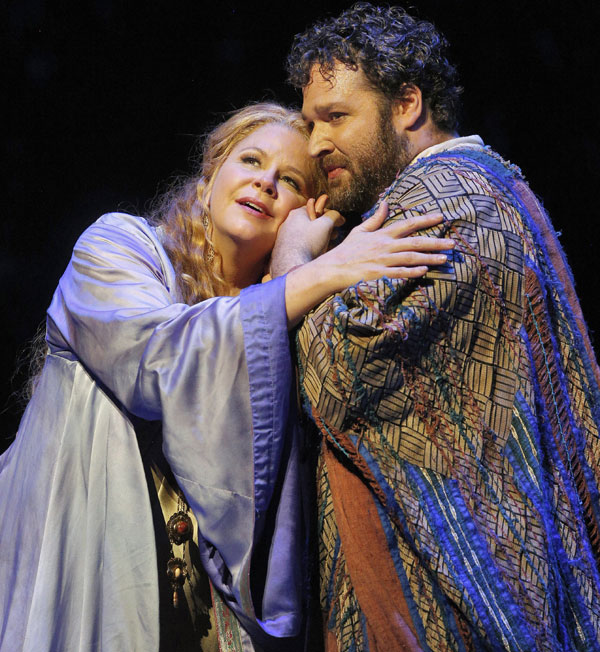 |
This is a huge draw-back for London and San Francisco alike. The director seems to wonder: what to do during the extended scenes of
passionate anticipation, the limb-melting romantic music Berlioz has written here? Let’s see: they could kiss. And then? Kiss again. Okay, but next? Well, how about another kiss? Alas, as the exchanges between Hymel and his queens don’t carry, the gorgeous melodies of the love duet don’t fully soar. What a difference in Paris (who would have thought?). Gregory
Kunde, with longish hair, trim body and bold eyes, has no pains enflaming his Dido. He does it with a decidedly manly reserve that only adds to his seduction, and plenty of lyricism in his voice. A slow crescendo of scenes builds toward the moment of love, beginning with the sumptuous orchestral interlude called “Chasse royale” (“Royal Hunt and Storm”). Next, a romantic quintet, “Everything conspires to vanquish her remose”, and an even more romantic,
achingly beautiful septet, “Only peace and enchantment surround us. Night spreads its veil…” In McVicar’s staging, all these scenes are busy, lacking concentration, whereas Kokkos holds the energies so tightly that the lovers seem to be naturally carried higher and higher in their anticipation of the love night: “Nuit d’amour et d’extase infinie...” The passionate duet has been compared to Tristan and Isolde, but
made me think of Berlioz’s song cycle “Nuits d’été” with its magic and whimsical notes of tender irony that Wagner wouldn’t have dreamt of. Perfectly sung and played out by Graham and Kunde, it’s a moment when all the elements of a music-drama--poetry, voluptuous music and onstage transmission--come together and heighten each other to create one of the most addictive love scenes I can think of in opera. Wings of Destiny In the long preparation for these heights, however, both productions blunder with the extended ballets Dido serves as entertainment for her guest. Kokkos goes for refined kitsch of stylized “Hellenistic” athletics; McVicar for embarrassing ballet acrobatics and scenes of frolicking satyrs and nymphs that rival any tawdry Venusberg. Both directors then atone by making charming use of a secondary
character, Ascanius, the adolescent son of Aeneas. It’s a small trouser role, whose main purpose in the story is to play Cupid and slip Dido’s wedding ring from her finger to free her for new love. McVicar gives the boy (handsome Barbara Senator on the DVD) golden wings and a bow to shoot arrows at Dido’s heart. The danger of humans playing destiny later comes back as the shadow of a huge
night-bird beating its wings against the city, announcing the dark ending of the tale with the ominous chorus echoing from back-stage: “Italy! Italy!” Yannis Kokkos gives Ascanius a much larger stage presence. Like Mozart’s Cherubino, Ascanius develops his own adolescent crush on Dido and knows how to ingratiate himself with her. At times arch and Puckish, clear-voiced soprano Stéphanie d’Oustrac is the proverbial naughty boy who fans everyone else’s flames with his charm and sexy innocence. The Bitter Ending
After two acts of growing passion, Berlioz shows a deeply torn Aeneas, despairing over having to break Dido’s heart. He sees no choice but to fulfill his mission, but confronted by her as a coward fleeing from love, he has no defense. Both Hymel and Kunde rise to the challenge of these stormy monologue and dialogue scenes. The same can be said for both Westbroek and Graham, but once again Susan Graham’s portrayal under Yannis Kokkos is carried by more passion and a
larger consciousness of her power. Her rage and outrage then are visceral. And once again these are scenes of extraordinary music-–“expressive through its lyrical eloquence and beauty of color,” as the London DVD booklet writes. Graham’s voice and acting carry the full extent of the betrayal Berlioz has written for her-- the howl of a woman who will not accept that her beloved ‘s destiny is to go away to die a hero’s death far away. Dido’s Death At the very end McVicar seems to have run out of steam. He has Dido wail in front of a stage closed off by a shabby black curtain, then stab herself on a funeral pyre that in San Francisco looked like a pile of junk. For some reason the pile was quite a bit higher in San Francisco than on the original London stage, forcing Graham’s Dido to awkwardly climb onto it and struggle to remain steady. She stabbed
herself with her faithless lover’s sword, then simply crumpled onto the heap.
Kokkos by contrast erects a staircase to immortality for Dido, high and white, as impeccable as the hatred she has found in herself in order to soothe her pain. She calls up the triumphant vision of the Carthagian hero who will one day come to avenge her and her people against Rome: “Hannibal! Hannibal!” McVicar at this moment fills the sky over the broken-up city with another prop. Huge and metallic like the Trojan horse, Hannibal looms like a scary warrior robot, a mix between King Kong and “Metal
Man.” The once so happy Carthagians roar their curse of Italy, ending the opera by violently swearing revenge: “May their massacre at our hands one day shock the world!”
In Paris, Dido dies spectacularly. She throws a red cloth down the staircase like a train of blood, then falls eloquently, resting high up on the stairs as if in flight. With a bit of musical and directorial license, director Kokkos and conductor Gardiner bring Antonacci back to the front of the stairs, dressed in black and embodying Clio, the goddess
of history. We hear the Trojan March in the background, but this time it is the triumphant apotheosis of the theme as Clio closes the epic with the simple latin statement: “Fuit Troja, stat Roma.” Even just on a DVD recording, I felt the large breath of history in this Paris ending: Did Dido really shout out “Hannibal!”, I wondered – or
did she shout “ISIS!” in an allusion to our contemporary world?
Photos - Cory Weaver, Marie Noelle Robert |